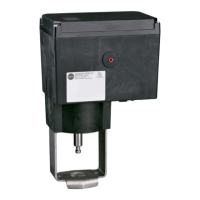16-6 EB 8331-4 EN
Annex A (conguration instructions)
16.5 Position feedback signal
The valve position feedback indicates the valve travel. It uses an analog signal issued at the
terminal U OUT or I OUT. The span of the position feedback signal is adjusted over the lower
and upper range value parameters.
− At least 2.5V or 5mA (depending on the input signal used) must separate the upper and
lower range values.
− When c37 = YES, the position feedback signal is 12V or 24mA in the event of a fault.
− During initialization, transit time measurement or zero calibration, the position feedback
signal = 0V or 0mA.
Code Description Default Adjustment range
c05 Unit mA mA (current signal)
V (voltage signal)
c06 Lower range value 4.0mA 0.0to7.5Vor
0.0to15.0mA
c07 Upper range value 20.0mA 2.5to10.0Vor
5.0to20.0mA
c37 Superimposing an error message NO YES (error reading active)
NO (error reading inactive)
16.6 Binary input
Thefunctionofthebinaryinputcanbeconguredasrequired.Codec12isusedtodeter-
mine the switching state for the active function. c12 = NINV: the binary input is active when
the input terminals IN4+/IN4– are connected with each other. c12 = INV: The binary in-
put is active when the connection between the input terminals IN4+/IN4– is interrupted.
Î Do not connect an external supply voltage to the input terminals.
− Inactive (c11 = NONE): No function is assigned to the binary input.
− Priority position (c11 = PRIO): The priority position is triggered and the actuator stem
moves to the position entered in Code c34 as soon as the binary input changes to the ac-
tive switching state. The valve leaves the priority position and follows the input signal af-
ter the binary input changes to the inactive switching state.
− Next entry in information level (c11 = NEXT): If the NEXT function is selected in
Codec11,therstcodeoftheinformationlevel(i01)isdisplayedassoonasbinaryin-
Note

